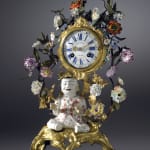Etienne Roquelon
Provenance
From the collection of an important Genovese family.
Literature
Geoffrey de Bellaigue, "The James A. de Rothschild Collection at Waddesdon Manor", 1974, vol. I, p. 99, illustrating a comparable clock in the Waddesdon Collection with similar Vincennes flowers and foliage but with a shepherdess and other figurines by Meissen. Pierre Kjellberg, "Encyclopédie de la Pendule Française du Moyen Age au XXe Siècle", 1997, p. 148, pls. A and C, illustrating two clocks with Chinese porcelain magots as well as other examples combining Parisian eighteenth century bronzes mounts with Chinese porcelain figurines.
An extremely fine Louis XV gilt bronze and porcelain 'Pendule au Magot' of eight day duration most probably commissioned by the marchand-mercier Lazare Duvaux, with movement by Etienne Roquelon, with a K'ang Hsi porcelain grotesque Chinaman or maggot, the porcelain flowers attributed to the Vincennes Factory and bronze work attributed to Jean-Joseph de Saint-Germain, signed on the white enamel dial and on the movement Roquelon à Paris, the dial with blue Roman and black Arabic numerals and a fine pair of gilt brass hands for the hours and minutes. The movement with anchor escapement, silk thread suspension, striking on the hour and half hour, with outside count wheel. The very beautiful case with painted enamel green trelliswork drum sides ornamented with flowers and seedpods, with mounted foliate scrolls around the bezel surrounded by an elaborate gilt bronze spray of stems and foliage issuing a variety of intricately modeled plain white and polychrome painted flowers including carnations, pinks, roses, jasmine and convolvulus with additional porcelain leaves, seated to the lower left of the dial is a magot, wearing a red floral patterned jacket, rosette decorated pantaloons and a gilt bronze hat, seated on a pierced and scrolled rocaille base
The magot: China K'ang Hsi period (1662-1722). The gilt bronzes mounts: Paris, date circa 1745.
The porcelain flowers: almost certainly Vincennes, date circa 1745
Height 39 cm.
Such a clock as this represented the taste for luxury, Eastern exoticism and high ornamentation which prevailed among the royal and aristocratic clientele during the mid eighteenth century. The intricacy and skill involved in creating such finely modeled flowers as these took the porcelain maker's skills to the limit. Yet the overall design of such objects was due to the marchands-merciers who not only promoted this fashion but probably created it. Among them were such men as Thomas-Joachim Hébert, Philippe-Simon Poirier, Dominique Daguerre but more particularly Lazare Duvaux who seems to have specialized in flower-decorated clocks such as this. As marchand-mercier he would have been responsible for purchasing the individual parts including the Chinaman, the porcelain flowers, the clock itself and the bronze work as well as the commissioning of an artisan for its final assembly. Due to the superb quality, the bronze work can be attributed to the eminent bronzier Jean-Joseph de Saint-Germain (1719-91), who produced a number of other comparable Rococo style cases.
As would be expected the flowers do not bear a factory mark but due to their quality and style are almost certainly by Vincennes, which from its foundation in July 1745 gained repute for its finely modeled flowers. Vincennes' success was such that less than three years later it was planning to enlarge the floral workshop which already employed 45 women. Flower heads such as these were not only used on clocks but also wall-lights, candelabra and other luxury objects. They were even sometimes scented and planted in borders, for instance when in 1750 Madame du Pompadour received Louis XV for the first time at her newly built Château de Bellevue, which the King had given her. A number of Vincennes porcelain flower clocks feature Meissen figurines, such as one example which Duvaux delivered to Louis XV's daughter, Mme Sophie in 1755, for which he charged 600 livres. This was about the average price for such a clock, the cheapest being about 432 livres for a clock sold to the duchesse de Lauraguais in 1750 and the most expensive being one sold to Madame de Pompadour in 1755 which cost 1,800 livres.
The present movement was supplied by Etienne Roquelon (d. 1776) who was received as a maître horloger in 1718 by privilege of the Trinity Hospital. By 1728 he was established at rue de la Savaterie and then in 1746 at rue Saint-Martin. Examples of his work can be found at the Jagdschloss, Moritsburg.



